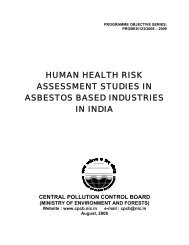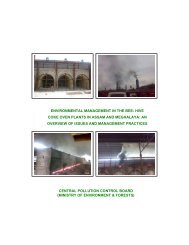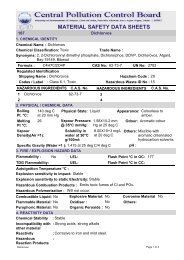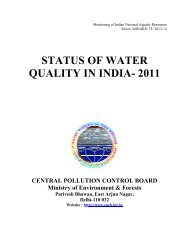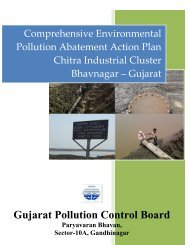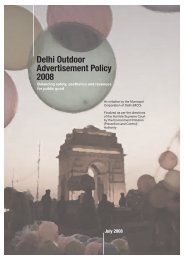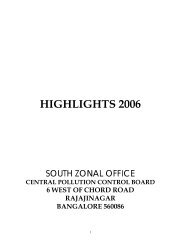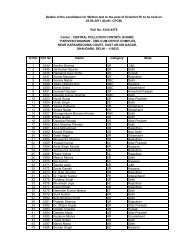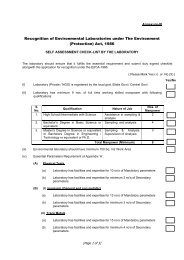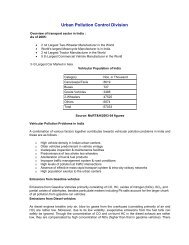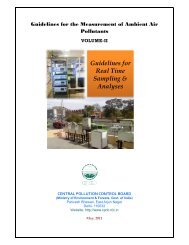comprehensive environmental pollution abatement action plan ...
comprehensive environmental pollution abatement action plan ...
comprehensive environmental pollution abatement action plan ...
Create successful ePaper yourself
Turn your PDF publications into a flip-book with our unique Google optimized e-Paper software.
;.<br />
, 0 t~2- ) [J - 3' o~'M<br />
ACTION PLAN<br />
Development of Comprehensive<br />
Environmental Pollution Abatement<br />
Action Plan for Critically Polluted Area <br />
Korba<br />
6I;IHATTISGAR<br />
•<br />
'=i"~......f<br />
~~<br />
Chhattisgarh Environment Conservation Board<br />
1-Tilak Nagar, Shiv Mandir Chowk,<br />
Avanti Vihar, Raipur (C.G.)<br />
Website: www.enviscecb.org<br />
Email: hocecb@gmail.com<br />
~<br />
JANUARY-2011
COMPREHENSIVE ENVIRONMENTAL POLLUTION<br />
ABATEMENT ACTION PLAN FOR CRITICALLY<br />
POLLUTED AREA KORBA<br />
TABLE OF CONTENTS<br />
EXECTUIVE SUMMARY<br />
1. INTRODUCTION............ 01<br />
1.1<br />
1.2<br />
1.3<br />
1.4<br />
1.5<br />
1.6<br />
1.7<br />
BACKGROUND ..<br />
LOCATION .<br />
DIGITIZED MAP WITH DEMARCATION OF GEOGRAPHICAL<br />
BOUNDARIES AND IMPACT ZONES .<br />
CEPI SCORE (AIR, WATER, LAND AND TOTAL) .<br />
TOTAL POPULATION AND SENSITIVE RECEPTORS ..<br />
ECO-GEOLOGICAL FEATURES .<br />
INDUSTRY CLASSIFICATION AND DISTRIBUTION .<br />
01<br />
01<br />
01<br />
02<br />
02<br />
02<br />
02-03<br />
2. WATER ENVIRONMENT 04<br />
2.1 PRESENT STATUS OF WATER ENVIRONMENT 04<br />
2.2 SOURCES OF WATER POLLUTION 04<br />
2.3 DETAILS OF WATER POLLUTING INDUSTRIES IN THE<br />
AREA/CLUSTER , , 05<br />
2.4 EFFLUENT DISPOSAL METHODS - RECIPIENT WATER BODIES<br />
ETC. 05<br />
2.5 QUANTIFICATION OF WASTEWATER POLLUTION LOAD AND<br />
RELATIVE CONTRIBUTION BY DIFFERENT SOURCES VIZ<br />
INDUSTRIAL/DOMESTIC 05<br />
2.6 ACTION PLAN FOR COMPLIANCE AND CONTROL OF<br />
POLLUTION 06-09<br />
3. AIR ENVIRONMENT 10<br />
3.1 PRESENT STATUS OF AIR ENVIRONMENT 10<br />
3.2 SOURCES OF AIR POLLUTION 10-11<br />
3.3 AIR POLLUTING INDUSTRIES IN THE AREA/CLUSTER 11<br />
3.4 IMPACT OF ACTIVITIES OF NEAR BY AREA ON THE CEPI<br />
AREA 11<br />
3.5 QUANTIFICATION OF THE AIR POLLUTION LOAD AND<br />
RELATIVE CONTRIBUTION BY DIFFERENT SOURCES 11<br />
3.6 ACTION PLAN FOR COMPLIANCE AND CONTROL OF<br />
POLLUTION.... 12-15<br />
4. LAND ENVIRONMENT 16<br />
4.1 SOIL CONTAMINATION 16-17<br />
4.2 GROUND WATER CONTAMINATION 17-19<br />
4.3 SOLID WASTE GENERATION AND MANAGEMENT 19-22
5. PPL MODEL............................................................................. 23<br />
5.1 IDENTIFICATION OF PROJECT PROPOSALS (FOR BOTH THE<br />
OPTION I.E. TECHNOLOGY INTERVENTION AND<br />
INFRASTRUCTURE RENEWAL) FOR IMPLEMENTATION UNDER<br />
THE PPP MODE UNDER THE ACTION PLAN........ 23<br />
5.2 IDENTIFICATION OF STAKEHOLDERS/AGENCIES TO BE<br />
INVOLVED AND TO EVOLVE FINANCIAL AND MANAGERIAL<br />
MECHANISMS FOR IMPLEMENTATION OF PPP PROJECTS 23<br />
6. OTHER INFRASTRUCTURAL RENEWAL MEASURES.......... 23<br />
6.1 GREEN BELTS..................................................................... 23<br />
6.2 DEVELOPMENT OF INDUSTRIAL ESTATE(S) 23<br />
6.3 DEVELOPMENT/SHIFTING OF INDUSTRIES LOCATED IN THE<br />
NON INDUSTRIAL AREAS TO THE EXISTING/NEW INDUSTRIAL<br />
ESTATES 23<br />
7. SPECIFIC SCHEMES 24<br />
7.1 GIS-GPS SYSTEM FOR POLLUTION SOURCES MONITORING ... 24<br />
7.2 HYDRO-GEOLOGICAL FRACTURING FOR WATER BODIES<br />
REJUVENATION 24<br />
7.3 IN-SITU REMEDIATION OF SEWAGE 24<br />
7.4 UTILIZATION OF MSW INERT BY GAS BASED BRICK KILNS 24<br />
7.5 CO-PROCESSING OF WASTES IN CEMENT INDUSTRIES 24<br />
8. PUBLIC AWARENESS AND TRAINING PROGRAMMES....................... 24<br />
9. OVERALL IMPACT OF INSTALLATIONI COMMISSIONING OF<br />
POLLUTION CONTROL EQUIPMENTS/MEASURES ON THE CEPI<br />
SCORE 25<br />
10. ASSESSMENT OF TECHNO-ECONOMICAL FEASIBILITY OF<br />
POLLUTION CONTROL SYSTEM IN CLUSTERS OF SMALL/MEDIUM<br />
SCALE INDUSTRIES 25<br />
11. EFFORTS SHALL BE MADE TO ENCOURAGE USE OF BIO-COMPOST<br />
AND BIO-FERTILIZER ALONGWITH THE CHEMICAL FERTILIZER IN<br />
THE STATE TO MINIMIZE THE UNUTILIZED CHEMICAL FERTILIZER<br />
RUN-OFF INTO THE NATURAL WATER RESOURCES FROM<br />
AGRICULTURE FIELDS......................... 25<br />
12. SUMMARY OF PROPOSED ACTION POINTS................................... 26<br />
12.1 SHORT TERM ACTION POINTS (UPTO 1 YEAR, INCLUDING<br />
CONTINUOUS ACTIVITIES) 26-27<br />
12.2 LONG TERM ACTION POINTS (MORE THAN 1 YEAR) 28-30<br />
13. ADDITIONAL INFORMATION-<br />
IMPROVEMENTS BEING DONE SINCE THE DECLARATION OF 30<br />
CRITICALLY POLLUTED AREA ..
LIST OF TABLES:<br />
TABLE-1<br />
TABLE-2<br />
TABLE-3<br />
TABLE-4<br />
TABLE-5<br />
TABLE-6<br />
TABLE-7<br />
TABLE-8<br />
TABLE-9<br />
TABLE-10<br />
TABLE-11<br />
TABLE-12<br />
TABLE-13<br />
TABLE-14<br />
CEPI SCORE (AIR, WATER, LAND AND TOTAL)... 02<br />
INDUSTRY CLASSIFICATION AND DISTRIBUTION 02<br />
RIVER WATER QUALITY FOR THE LAST THREE YEARS 04<br />
THE BREAKUP OF THE INDUSTRIAL AS WELL AS DOMESTIC<br />
WASTE WATER GENERATED FROM THE INDUSTRIES... ... 05<br />
COST ESTIMATE OF THE VARIOUS WATER COMPONENTS 08<br />
AIR MONITORING DATA UNDER NAMP PROGRAMME FOR THE<br />
LAST THREE YEARS 10<br />
THE BREAKUP OF THE INDUSTRIAL AIR POLLUTION LOAD<br />
GENERATED BY THE INDUSTRIES 11<br />
COST ESTIMATE OF THE VARIOUS AIR COMPONENTS 14<br />
CRITICAL LOCATIONS OF FLY ASH DISPOSAL OF VARIOUS<br />
POWER PLANTS LYING IN KORBA PROBLEM AREA 16<br />
CRITICAL LOCATIONS OF GROUND WATER MONITORING<br />
STATIONS AND THE PRESENT STATUSIQUALITY OF GROUND<br />
WATER 18<br />
THE HAZARDOUS WASTE GENERATED IN KORBA ARE<br />
CLASSIFIED AND TABULATED ALONG-WITH THEIR<br />
CATEGORY AND QUANTITy.................. 19<br />
INDUSTRY WISE UTILIZATION OF FLY ASH 21<br />
SHORT TERM ACTION POINTS (UPTO 1 YEAR, INCLUDING<br />
CONTINUOUS ACTIVITIES) 26-27<br />
LONG TERM ACTION POINTS (MORE THAN 1 YEAR) 28-30<br />
PHOTOGRAPHS:<br />
PHOTO-1 DHANRAS ASH POND OVERFLOW POINT SHOWING ZERO<br />
DISCHARGE STATUS OF MIS NTPC LTD. 31<br />
PHOTO-2 : DISPLAY OF ONLINE MONITORING SYSTEM AT MAIN GATE<br />
OF MIS NTPC LTD. 31<br />
PHOTO-3 : INSTALLATION OF CAAQMS OF MIS NTPC LTD. 32<br />
PHOTO-4 : CIVIL WORK UNDER PROGRESS OF HCDS SYSTEM OF MIS<br />
CSEB (E) 32<br />
PHOTO-5 : DUEL FLUE GAS CONDITIONING SYSTEM OF MIS CSEB (E) 33<br />
PHOTO-6 : CONTROL ROOM OF DUEL FLUE GAS CONDITIONING<br />
SYSTEM OF MIS CSEB (E) 33<br />
PHOTO-7 WORK UNDER PROGRESS FOR CONVEYER SYSTEM OF<br />
HCSD OF MIS CSEB (E) . 34<br />
PHOTO-8 : WORK UNDER PROGRESS FOR CONSTRUCTION OF SILO IN<br />
MIS CSEB (E) 34<br />
PHOTO-9 CONSTRUCTION OF SILO FOR DRY ASH COLLECTION OF MIS<br />
CSEB (W) 35<br />
PHOTO-10 CONSTRUCTION OF CONVEYER SYSTEM OF MIS CSEB (W)... 35<br />
PHOTO-11 HOPPER BOTTOM FOR PREPARATION OF HC SLURRY MIS<br />
CSEB (W) ... ... ... ... ... ... ... ... ... ... ... ... ... ... ... ... ... ... ... ... ... ... ... ... ... 36<br />
PHOTO-12 INSTALLATION OF CONTROL PANEL FOR HCDS SYSTEM OF<br />
MIS CSEB (W) 36<br />
PHOTO-13 SILOS UNDER FINAL STAGE OF INSTALLATION FOR DRY ASH<br />
COLLECTION OF MIS CSEB (EXPANSION PROJECT) 37<br />
PHOTO-14 : PUMP FOR HCSD SYSTEM OF MIS BALCO (540 MW) 38
PHOTO-15<br />
PHOTO-16<br />
PHOTO-17<br />
ASH SILO FOR COLLECTION OF DRY FLY ASH OF MIS BALCO<br />
(540 MW) .. , ,. 38<br />
A VIEW OF ASH POND BASED ON HCSD SYSTEM OF MIS<br />
BALCO (540 MW) , , .. 39<br />
PHOTOGRAPHS SHOWING UPGRADATION WORK OF ESP BY<br />
INSTALLATION OF HYBRID BAG FILTER BY MIS BALCO (540<br />
MW) 40<br />
LIST OF FIGURES:<br />
FIGURES-1<br />
FIGURES-2<br />
SHOWING KORBA REGION OF 15 KM RADIUS WITH KORBA<br />
TOWNSHIP AS EPICENTER 41<br />
SHOWING INDUSTRIAL SETUP OF MIS NTPC, MIS CSEB (E),<br />
MIS CSEB (W) & MIS BALCO WITH THEIR TOWNSHIPS AT<br />
KORBA 42
1. INTRODUCTION<br />
1.1 Background.<br />
• CPCB had earlier declared Korba as one of the 24 critically<br />
polluted areas.<br />
• A Review Committee under the Chairpersonship of Chairman,<br />
CPCB and senior officers from CPCB and CECB as members was<br />
constituted to periodically review the <strong>pollution</strong> level and <strong>abatement</strong><br />
measures.<br />
• A joint meeting of CPCB and CECB along-with the representatives<br />
of the major industries of Korba region was held on 2 nd _3 rd July,<br />
2008 to review the <strong>action</strong> <strong>plan</strong> for <strong>abatement</strong> measures.<br />
• Further review meeting of CPCB and CECB along-with the<br />
representatives of the major industries of Korba region was held<br />
on 10th February, 2010 to review the <strong>action</strong> <strong>plan</strong> for <strong>abatement</strong><br />
measures.<br />
1.2 Location.<br />
• Korba is located at 82° 42' 30" E longitude and 22° 21' N latitude in<br />
the eastern part of Chhattisgarh State. It is on the left bank of the<br />
Hasdeo River which is a major tributary of Mahanadi River. Ahiran<br />
is another river in the area that joins Hasdeo River.<br />
• It is about 238 kilometers by road from capital city Raipur. Coal is<br />
the major natural resource available in this region. Major power<br />
generating units of the state have come up in Korba owing to huge<br />
reserves of coal.<br />
• Korba is popularly known as power hub of India.<br />
1.3 Digitized Map with Demarcation of Geographical Boundaries and<br />
Impact Zones.<br />
• The industrial activities within 15 km radius from Korba town may<br />
be considered as critically polluted. Map showing location of<br />
industries has been shown at figure-1 of page 41.<br />
• The digitized map shows townships of NTPC, CSEB (East), CSEB<br />
(West), BALCD and Small Industrial Area Korba.<br />
• The digitized map at figure-2 of page 42 also shows prominent<br />
features like Hasdeo River and Barrage, Various Ash Dyke of<br />
Power Plants, Belgiri Nallah, Dengur Nallah and Township of<br />
Korba.<br />
-1-
1.4 CEPI Score (Air, Water, Land and Total).<br />
Table-1<br />
Air<br />
67<br />
Water<br />
57<br />
Land<br />
72.50<br />
Total<br />
83<br />
With a CEPI index 83, Korba is placed at no. 05 in the list of<br />
critically polluted industrial areas/clusters in descending order.<br />
1.5 Total Population and sensitive receptors.<br />
• Presently the population of Korba is around 03 Lacs.<br />
• A government hospital comprising of 100 beds, 03 colleges, 15<br />
schools, 01 district court are situated in the township.<br />
• Ministry of Environment & Forests, Government of India, New<br />
Delhi (MoEF), vide their office memorandum dtd. 15/03/2010,<br />
demarcated boundary for the industrial area for the purpose of<br />
Critically Polluted Areas and accordingly critical area in Korba<br />
comprises of:<br />
(a) Industrial areas and their townships of NTPC, BALCO, CSEB<br />
(East) & CSEB (West)<br />
(b) Korba Town<br />
1.6 Eco-geological features.<br />
1.6.1 Major Water Body - Hasdeo River<br />
1.6.2 Ecological sensitive areas - Nil<br />
1.6.3 Buildings or Monuments of Historical/archaeological/religious<br />
importance - Nil<br />
1.7 Industry classification and distribution.<br />
Table-2<br />
Large Medium Small<br />
1.7.1 Highly Polluting industries - 07 01 Nil<br />
1.7.2 Red category industries - 07 01 04<br />
1.7.3 Orange and Green - Nil Nil Nil<br />
category industries<br />
1.7.4 Grossly Polluting industries - 04 Nil Nil<br />
/ Mines<br />
-2-
MAJOR INDUSTRIES IN KORBA<br />
(Situated Within the Critical Area>.<br />
1- Mis N.T.P.C. Ltd., Korba Super Thermal Power Station, Jamnipali, Korba<br />
(3x200=600 MW+3x500 = 1500 MW - Total 2100 MW)<br />
2- Mis Chhattisgarh State Electricity Board (CSEB),<br />
Hasdeo Thermal Power Station, Korba (West), Korba (4x21 0 = 840 MW)<br />
3- Mis Chhattisgarh State Electricity Board (CSEB),<br />
Korba Thermal Power Station, Korba (East), Korba<br />
(4x50=200 MW+2x120 =240 MW = Total 440 MW)<br />
4- Mis Chhattisgarh State Electricity Board (CSEB),<br />
Dr. Shyama Prasad Mukherjee Thermal Power Plant, Korba (East), Korba<br />
(2x250=500 MW)<br />
5- Mis Bharat Aluminium Co. Ltd., Balco Nagar, Korba<br />
(Aluminium Smelter Plant [Alumina-3,30,000 TPA & Hot Metal (Fabrication)-3,70,000<br />
TPAD<br />
6- Mis Bharat Aluminium Co. Ltd., Balco Nagar, Korba (CPP-2)<br />
(4 x 135 = 540 MW)<br />
7- Mis Bharat Aluminum Company Limited (CPP-1)<br />
Balco Captive Power Plant, Jamnipali, Korba<br />
(4 x 65.5 = 270 MW)<br />
8- Mis Gevra Open Cast Mines, SECL, Korba (35 MTPA)<br />
9- Mis Dipka Open Cast Mines, SECL, Korba (25 MTPA)<br />
10- Mis Kusmunda Open Cast Mines, SECL, Korba (10 MTPA)<br />
11- Mis Lanco Amarkantak Power Private Limited, Village-Pathadi, Tehsil-Korba, Korba<br />
(2x300 MW TPP)<br />
EXPANSION UNITS UNDER CONSTRUCTION, WHICH HAVE BEEN<br />
GRANTED ENVIRONMENTAL CLEARANCE BEFORE GOVERNMENT OF<br />
INDIA NOTIFICATION DATED 13/01/2010<br />
{Situated Within the Critical Area}<br />
1- Mis N.T.P.C. Ltd., Korba Super Thermal Power Station, Jamnipali, Korba<br />
(1 x500=500 MW)<br />
2- Mis Chhattisgarh State Electricity Board,<br />
Hasdeo Thermal Power Station, Korba (West), Korba (1 x500 = 500 MW)<br />
3- Mis Bharat Aluminium Co. Ltd., Balco Nagar, Korba (4x300 = 1200 MW)<br />
4- Mis Bharat Aluminium Co. Ltd., Balco Nagar, Korba (1x300 = 300 MW)<br />
5- Mis Bharat Aluminium Co. Ltd., Balco Nagar, Korba (Alumina Smelter-5.5 LTPA)<br />
6- Mis Lanco Amarkantak Power Private Limited, Village-Pathadi, Tehsil-Korba, Korba<br />
(660 MW + 660 MW TPP)<br />
7- Mis Indo Sponge Power & Steel Private Limited, Rajgamar Road, Korba (Sponge<br />
Iron-100 TPD)<br />
8- Mis Himadri Chemicals Industries, Jaghara, Korba (Liquid Coal Tar Pitch-30,000<br />
TPD)<br />
9- SSI Industries located in the industrail area Korba are mainly-<br />
(i) Mis Shiva Industries<br />
(ii) Mis Star Ferro Alloys<br />
(iii) Mis R. R. Ferro Alloys<br />
(iv) Mis Bhajanka Ferro Alloys<br />
(v) Mis Vinay Industries<br />
(vi) Mis Jaiswal Oxides.<br />
Note: - All the SSI units are complying with the standards prescribed by the Board.<br />
Regular monitoring is being carriedout by Regional Office, Korba.<br />
-3-
2. WATER ENVIRONMENT<br />
2.1 Present status of water environment.<br />
• River Hasdeo is the main water body in Korba which receives<br />
industrial as well as domestic effluent.<br />
• Regular water sampling work is being done at upstream and<br />
downstream of Hasdeo River.<br />
• River water quality for the last three years is as follows: -<br />
Table-3<br />
Quality of Parameters<br />
Sample pH Suspended Disoloved BOD COD<br />
Town River Collecti Year (pH Solids Oxygen (mg/lit) (mg/lit)<br />
on Unit) (mg/lit) (mg/lit)<br />
Points<br />
Korba Hasdeo Near 2008 6.9-7.5 69-89 6.0-7.2 1.4-2.7 8-20<br />
Hasdeo 2009 7.2-7.3 42-58 6.7-7.6 1.2-1.6 20-26<br />
Barrage 2010 7.1-7.1 43-47 6.0-6.5 2.0-3.3 30-38<br />
Near 2008 6.8-7.4 85-133 6.1-7.4 1.8-3.3 16-46<br />
Village 2009 7.0-7.3 60-96 6.0-6.8 2.2-3.8 22-40<br />
Urga 2010 7.0-7.1 52-65 5.3-5.9 3.0-4.1 40-48<br />
As shown above, there is improvement of parameters in the year 2010<br />
as compared to previous year. Presently, river is of class - B as per 18-2296<br />
i.e. water quality is fit for bathing only.<br />
2.2 Sources of water <strong>pollution</strong>.<br />
2.2.1 Industrial - Ash pond overflow water from coal based power<br />
<strong>plan</strong>ts.<br />
2.2.2 Domestic - Colonial waste from township of the power units as<br />
well as Korba township.<br />
2.2.3 Others - Nil.<br />
2.2.4 Impact on surrounding area - The quality of the river water is<br />
affected due to disposal of ash pond overflow which joins river<br />
water.<br />
-4-
2.3 Details of Water Polluting Industries in the area/cluster.<br />
• There are presently 06 coal based power <strong>plan</strong>ts with total<br />
generation 4700 MW and a aluminum smelter unit situated in the<br />
critically problem zone at Korba.<br />
• The main source of water <strong>pollution</strong> is the overflow of ash pond in<br />
all the power <strong>plan</strong>ts.<br />
2.4 Effluent Disposal Methods - Recipient water bodies etc.<br />
• Traditional treatment of ash slurry method is being used in the all<br />
the power <strong>plan</strong>ts having ash pond with discharge shaft.<br />
• The ash slurry gets· settled in the ash pond and<br />
decanted/supernatent water is either recycled or discharged into<br />
the near-by nallah.<br />
• All the ash ponds are situated near the natural streams/river such<br />
as Dengur Nallah, Belgiri Nallah, Jharia Nallah which ultimately<br />
joins into the downstream of the Hasdeo river.<br />
• NTPC, LANCO, CSEB expansion project power <strong>plan</strong>ts have total<br />
recirculation system for ash pond overflow water. BALCO (CPP-2)<br />
has established High Concentrated Slurry System for disposal of<br />
ash slurry.<br />
2.5 Quantification of wastewater <strong>pollution</strong> load and relative<br />
contribution by different sources viz industrial/domestic.<br />
• Total waste water generated from the critically polluted area is<br />
approximately 2,00,000 KLPD.<br />
• The breakup of the industrial as well as domestic waste water<br />
generated from the industries is tabulated below: -<br />
Table-4<br />
s. Name of Industry Industrial Domestic<br />
No. Waste Water Waste Water<br />
(KLPD) (KLPD)<br />
01- Mis N.T.P.C. Ltd.* 26,009 9,350<br />
02- Mis CSEB (West) 37,920 7,607<br />
03- Mis CSEB (East) 43,003 6,509<br />
04- Mis Dr. Shyama. Prasad 23,212 Nil<br />
Mukherjee (CSEB)*<br />
05- Mis BCPP (CPP-1-270 33,133 1,027<br />
MW)<br />
06- Mis BALCO (CPP-2-540 12,211 182<br />
MW)<br />
* Total re-circulation of over flow water from the ash pond of NTPC<br />
& Dr. Shyama Prasad Mukherjee power <strong>plan</strong>ts has been<br />
established.<br />
-5-
2.6 Action Plan for compliance and control of <strong>pollution</strong>.<br />
2.6.1 Infrastructure facilities.<br />
(A) Existing-<br />
• Total re-circulation scheme for ash pond over flow has been<br />
adopted by NTPC and CSEB expansion project, Korba.<br />
• BALCe (CPP-1-540 MW) has established High<br />
Concentrated Slurry Disposal System (HCSD) for fly ash.<br />
• CSEB (E & W) are in the process of establishing High<br />
Concentrated Slurry Disposal System (HCSD) along-with dry<br />
ash collection system. The work is under progress.<br />
• BALCe (CPP-1-270 MW) has been directed to submit<br />
preliminary feasibility report for the adoption of HCSD system<br />
within the period of three months.<br />
• BALCe is in the process of establishment of STP for the<br />
colonial waste generated in their residential colony. Details<br />
are awaited.<br />
2.6.2 Pollution control measures installed by Industries.<br />
• Central Monitoring Basin has been provided by Mis NTPC<br />
Ltd., Mis CSEB (Expansion Project) and Mis BALCe Captive<br />
Power Plant (540 MW).<br />
• Ash pondlash dykes have been provided in all the power<br />
<strong>plan</strong>ts for traditional treatment of ash slurry.<br />
• Total re-circulation scheme for ash pond over flow has been<br />
adopted by NTPC and CSEB expansion project, Korba.<br />
• High Concentrated Slurry Disposal System has been<br />
provided in Mis BALCe Captive Power Plant (540 MW).<br />
2.6.3 Technology Intervention.<br />
2.6.3.1 Inventorisation of prominent industries with technology<br />
gaps.<br />
• In comparison to old traditional system of slurry<br />
disposal for fly ash, the new technology i.e. High<br />
Concentrated Slurry Disposal System (HCSD)<br />
requires less volume of water to handle as well as<br />
lesser land area.<br />
• CSEB (E & W) are in the process of establishment<br />
of High Concentrated Slurry Disposal System<br />
(HCSD) along-with dry ash collection system. The<br />
construction work is under progress.<br />
(B) Proposed-<br />
-6-
2.6.3.2 Identification of low cost and advanced cleaner<br />
technology for <strong>pollution</strong> control.<br />
2.6.4 Infrastructure Renewal.<br />
• BALCO is in the process of establishment of STP<br />
for the waste generated in their residential colony.<br />
2.6.4.1 Details of existing infrastructural facilities.<br />
• As mentioned at 2.6.1 (A).<br />
2.6.4.2 Need of up gradation of existing facilities.<br />
• In order to reduce <strong>pollution</strong> load in near by water<br />
bodies and to ensure optimum use of land, it is<br />
necessary to adopt High Concentrated Slurry<br />
Disposal System (HCSD). The requirement of<br />
water consumption is considerably low as<br />
compared to old traditional system of ash slurry<br />
disposal.<br />
2.6.4.3 De-silting of water tanks, drains, rivulets etc.<br />
• Ash dyke overflow of CSEB (E) is being<br />
discharged into the Dengur Nallah. Seepage water<br />
from abandoned red mud ponds also gets<br />
discharged into Belgiri Nallah. This two water<br />
bodies traverses 07 km to join finally into Hasdeo<br />
River. Therefore, de-silting of both the above<br />
Nallahs is needed to enhance its water holding<br />
capacity.<br />
2.6.4.4 Construction of lined drains/connections.<br />
• Risda, Podimar (Phase-I & II) ash pond of CSEB<br />
(E) and Parsabhata ash pond of BALCO are<br />
situated on the bank of Dengur Nallah and Belgiri<br />
Nallah respectively. To avoid any <strong>environmental</strong><br />
hazard due to accidental collapse/sliding of ash<br />
pond embankment, particularly during monsoon,<br />
construction of lined/stone pitching of Belgiri<br />
Nallah and Dengur Nallah is required in the stretch<br />
which is adjacent to the said ash ponds.<br />
-7-
2.6.4.5 Treatment and management of contaminated surface<br />
water bodies.<br />
• Construction of small anicut in the downstream of<br />
Hasdeo River at a distance of 04 km from the<br />
confluence of Dengur Nallah and Hasdeo river is<br />
required to provide adequate settling time for<br />
settlables.<br />
• Construction of small anicuts/check dams on<br />
Dengur Nallah is also required to provide adequate<br />
settling time.<br />
2.6.4.6 Rejuvenation/Management Plan for important ecogeological<br />
features.<br />
• Presently not required.<br />
2.6.4.7 Carrying of effluent from industrial units locate in nonindustrial<br />
locations to CETP facilities by lined<br />
drains/pipelines only and prevention of their disposal<br />
into city sewerage/surface drains.<br />
• Establishment of CETP is presently not required.<br />
2.6.4.8 Installation of Gen sets at CETPs.<br />
• Not applicable.<br />
2.6.5 Managerial and Financial aspects.<br />
2.6.5.1 Cost and time estimates.<br />
• Cost estimate of the various components included<br />
is tabulated as below: -<br />
Table-5<br />
s. Components Approx. Estimate Time Estimate<br />
No.<br />
Cost<br />
01- Sewage Treatment Rs. 04 Crores 24 months from<br />
Plant for Domestic (@ Rs. 1,000 per the date of<br />
Waste Water. cubic meter of sanction.<br />
effluent)<br />
02- Development of Infrastructure Facility<br />
(a) Interception and Rs. 02 Crores 18 months from<br />
diversion of (Lump Sum) the date of<br />
sewage.<br />
sanction.<br />
03- Cleaning/de-silting of Rs. 05 Crores 18 months from<br />
Dengur Nallah. (Lump Sum) the date of<br />
sanction.<br />
04- Cleaning/de-silting of Rs. 05 Crores 18 months from<br />
Belgiri Nallah. (Lump Sum) the date of<br />
sanction.<br />
Total<br />
Rs. 16 Crores<br />
-8-
2.6.5.2 Identified Private/Public sector potential investors &<br />
their contribution/obligation.<br />
• Presently not available.<br />
2.6.5.3 Government Budgetary support requirement.<br />
• Presently no budget allocation available.<br />
2.6.5.4 Hierarchical and structured managerial system for<br />
efficient implementation.<br />
• Implementation of above mentioned activities<br />
except activities mentioned in item no. 1, 2, 3 & 4<br />
at 2.6.5.1 and 2.6.4.5 are to be taken up by the<br />
industries individually. Accordingly, the industries<br />
themselves shall have to develop hierarchical and<br />
structured managerial system for efficient<br />
implementation.<br />
2.6.6 Self monitoring system in industries (ETPs etc.).<br />
• All the power <strong>plan</strong>ts and BALCD Aluminum Smelter Plant<br />
lying in Korba critical area have their own monitoring system<br />
for ETP.<br />
2.6.7 Data linkages to SPCB/CPCB (of monitoring devices).<br />
• All the power <strong>plan</strong>ts and BALCD Aluminum Smelter Plant<br />
situated in the Korba critical area have <strong>environmental</strong> cell<br />
along-with their own monitoring network. The data generated<br />
by the industries are not linked online with the Board.<br />
However, the monitoring reports are being submitted to the<br />
CECB regularly.<br />
• Online monitoring system linked with websites of regional offices<br />
and head office of CECB are proposed to be included in the <strong>plan</strong>.<br />
Target date - 31/03/2011.<br />
• Mis NTPC has already established 04 nos. of CAAQMS at<br />
Jamnipali, Korba. Also, procurement of 02 nos. of CAAQMS by<br />
Mis Lanco is under progress.<br />
• Mis BALCO has provided 01 no. of CAAQMS at Siltara, Phase-II,<br />
Raipur which is in operation.<br />
• Mis SECL (Gevra, Dipka & Kusmunda Mine Area) is in the<br />
process of procurement of CAAQMS at Korba.<br />
-9-
3. AIR ENVIRONMENT<br />
3.1 Present status of Air environment.<br />
3.1.1 Critical location for air quality monitoring.<br />
• Three nos. of monitoring stations have been selected by the<br />
Board in consultation with CPCB, New Delhi under NAMP<br />
programme.<br />
• The main locations of monitoring stations are Pragati Nagar,<br />
Jamnipali, Korba, ITI, Rampur and Near Tehsil Office,<br />
Rampur.<br />
• The air monitoring under NAMP programme is being carried<br />
out regularly since year 1995.<br />
3.1.2 Present levels of pollutants in air.<br />
• Air monitoring data under NAMP programme for the last<br />
three years are tabulated as below: -<br />
Table-6<br />
Quality of Parameters<br />
RSPM SPM Sulphur Oi Nitrogen Oi<br />
Town Location Year (mg/m3) (mg/m3) Oxide Oxide<br />
(mg/m3) (ma/m3)<br />
Korba Pragati 2008 89-114 189-237 11-14 18-23<br />
Nagar, 2009 64-141 140-292 10-15 18-24<br />
Jamnipali 2010 81-113 173-238 10-14 18-22<br />
ITI, Rampur 2008 100-127 211-264 11-15 19-24<br />
2009 82-155 173-316 11-17 19-26<br />
2010 101-144 195-299 12-15 19-23<br />
Near Tehsil 2008 92-120 188-249 11-15 19-23<br />
Office, 2009 70-155 156-320 11-16 18-25<br />
Rampur 2010 105-132 212-279 11-15 19-23<br />
Standard limit 100 200 80 80<br />
3.2 Sources of Air Pollution.<br />
• The main sources of industrial air <strong>pollution</strong> are Coal Based Power<br />
Plants and Smelter Plant.<br />
• This area also comprises of large open cast mines of SECL i.e.<br />
Dipka, Gevra and Kusmunda. The main source of problem of<br />
fugitive emission in Korba are as below: -<br />
-10-
1- Large scale transportation of coal.<br />
2- Blowing of fly ash from ash pond specially during summer<br />
season.<br />
3- Un-organized burning of coal in the areas Le. Sitamani,<br />
Parsabhata and near by areas by the dwellers.<br />
4- Heavy vehicular traffic.<br />
3.3 Air Polluting Industries in the area/cluster.<br />
• The main air polluting industries situated in the Korba critical areal<br />
industrial cluster are MIs NTPC, CSEB (E & W), MIs BALCe (540<br />
MW & 270 MW), MIs CSEB (Expansion Project 500 MW), MIs<br />
BALCe (Smelter Plant) and Dipka, Gevra and Kusmunda mines of<br />
SECL. List of industries is shown at 1.7.<br />
3.4 Impact of activities of near by area on the CEPI Area.<br />
• There are 02 Coal Based Power Plants having 600 MW capacity in<br />
operation in the near by area of the CEPI area. In addition to this<br />
07 Coal Based Power Plants having 3770 MW capacity are<br />
proposed in the near by areas. List of proposed industries is<br />
shown at 1.7.<br />
3.5 Quantification of the air <strong>pollution</strong> load and relative contribution by<br />
different sources.<br />
• Total air <strong>pollution</strong> load generated from the critically polluted area is<br />
approximately 36 tonnes per day. This load has been estimated on<br />
the basis of maximum stack emissions observed in the recent<br />
past.<br />
• The breakup of the industrial air <strong>pollution</strong> load generated are<br />
tabulated as below: -<br />
Table-7<br />
s. Name of Industry Estimated Industrial Air<br />
No.<br />
Pollution (TPD)<br />
01- MIs N.T.P.C. Ltd. 19.0<br />
02- MIs CSEB (West) 9.0<br />
03- MIs CSEB (East) 3.0<br />
04- MIs Dr. Shyama Prasad 1.0<br />
Mukherjee (CSEB)<br />
05- MIs BCPP (CPP-1 - 270 MW) 3.0<br />
06- MIs BALCe (CPP-2 - 540 MW) 1.0<br />
Total 36.0<br />
-11-
3.6 Action Plan for compliance and control of <strong>pollution</strong>.<br />
3.6.1 Infrastructure facilities.<br />
(A) Existing-<br />
• All the industries have developed ambient air quality network<br />
with High Volume Sampler and Stack Monitoring Instrument<br />
for monitoring of ambient as well as stack emission level.<br />
• NTPC has already established four nos. of Continuous<br />
Ambient Air Monitoring Stations at Jamnipali, Korba.<br />
• Opacity meters has been provided in all the power <strong>plan</strong>ts to<br />
monitor online dust emission from the stack.<br />
(8) Proposed-<br />
• Procurement of Continuous Ambient Air Monitoring Stations<br />
at Mis Lanco, CESB (E & W), Gevra and Dipka of SECL<br />
mines are in progress.<br />
3.6.2 Pollution control measures installed by the individual<br />
sources of <strong>pollution</strong>.<br />
(A) Existing-<br />
• ESP's have been provided in all the power <strong>plan</strong>ts.<br />
• Duel Flue Gas Conditioning System have been provided<br />
additionally to mitigate the excessive emission level.<br />
• BALCO (CPP-1-540 MW) has upgraded one of its ESP's<br />
with Hybrid Bag Filter.<br />
• CSEB (E & W) have also introduced Sulphur Smelter for S03<br />
along-with Ammonia Fogging System to reduce the resistivity<br />
of fly ash.<br />
(8) Proposed-<br />
• Augmentation and retrofitting of ESP's in old power <strong>plan</strong>ts of Mis<br />
CSEB (E & W) and Mis BCPP are in progress. Target date<br />
31/03/2011.<br />
• Augmentation and retrofitting of ESP's in old power <strong>plan</strong>ts of Mis<br />
NTPC is also in progress. Target date-31/12/2012.<br />
• Installation of Hybrid Bag Filters in unit nO.-01 of 540 MW of<br />
Balco has been completed. Work for installation of Hybrid<br />
Bag Filter in unit nO.-02 is in progress. Target date<br />
31/03/2011.<br />
• Installation of Hybrid Bag Filters in unit nO.-03 & 04 of 540<br />
MW of Balco is in progress. Target date-31/12/2011.<br />
3.6.3 Technology Intervention<br />
3.6.3.1 Inventorisation of prominent industries with<br />
technological gaps.<br />
• Earlier emission level introduced by the Board was<br />
in the range of 150-250 Mg/Nm 3 . Accordingly,<br />
<strong>pollution</strong> control equipments were designed and<br />
established in the old power <strong>plan</strong>ts.<br />
-12-
• Due to non availability of adequate space for<br />
installation of additional fields of ESP, it was<br />
difficult to meet the prescribed standards of the<br />
Board by these old power <strong>plan</strong>ts.<br />
• Poor quality of coal having more than 45% ash<br />
content is being used by all the power <strong>plan</strong>ts. This<br />
high ash content coal resulted in malfunctioning<br />
and frequent tripping of the existing <strong>pollution</strong><br />
control devices.<br />
• Feasibility of Captive Beneficiation <strong>plan</strong>t within the<br />
<strong>plan</strong>t premises may be explored and installed<br />
accordingly, instead of usage of high ash content<br />
coals in power <strong>plan</strong>ts. Proposal is being prepared<br />
by SECL.<br />
3.6.3.2 Identification of low cost and advanced cleaner<br />
technology for air <strong>pollution</strong> control.<br />
• With the advent of advanced technology, CECB<br />
revised the stack emission standards to 50<br />
Mg/Nm 3 looking into the clusters of power <strong>plan</strong>ts<br />
being established.<br />
• In order to meet the prevailing norms of the Board,<br />
all power <strong>plan</strong>ts have introduced Duel Flue Gas<br />
Conditioning System and BALCO has upgraded<br />
one of its ESP's with Hybrid Bag Filters.<br />
3.6.3.3 Introduction and switch over to cleaner fuel/washed<br />
coal.<br />
• Use of CleanlWashed Coal in the upcoming power<br />
<strong>plan</strong>ts in the near by areas shall be mandated to<br />
reduce the air <strong>pollution</strong> load.<br />
3.6.4 Need of infrastructure Renovation.<br />
3.6.4.1 Development of roads.<br />
• Approach roads to these power <strong>plan</strong>ts are<br />
presently in bad shape resulting into heavy fugitive<br />
emissions due to large number of coal<br />
transportation and heavy traffic density.<br />
• Repairing and widening of the RCC roads for the<br />
total length of 20 km approach road from pit head<br />
to various power heads are proposed in the<br />
development of infrastructure facilities.<br />
3.6.5 Impact on CEPI score after installation/commissioning of full<br />
fledged air <strong>pollution</strong> control system.<br />
• With the up-gradation of all existing <strong>pollution</strong> control system<br />
in the industries of Korba problem area, it is expected that<br />
the CEPI score will be considerably reduced.<br />
-13-
3.6.6 Managerial and Financial aspects<br />
3.6.6.1 Cost and time estimates.<br />
• Cost estimate of the various components included<br />
is tabulated as below: -<br />
Table-8<br />
s. Components Approx. Time Estimate<br />
No.<br />
Estimate Cost<br />
01- Development of Infrastructure Facility<br />
Repairing and widening Rs. 25 Crores 12 months<br />
of the RCC roads for (Lump Sum) from the date<br />
the total length 20 km.<br />
of sanction.<br />
02- Plantation Rs. 05 Crores Following<br />
(Lump Sum) monsoon<br />
season after<br />
the date of<br />
sanction.<br />
03- Setting up of CAAQMS Rs. 05 Crores 12 months<br />
with weather station (Lump Sum) from the date<br />
monitoring instruments of sanction.<br />
at Industrial Clusters,<br />
Korba.<br />
04- Development of online Rs. 01 Crore 12 months<br />
facility for data linkage (Lump Sum) from the date<br />
of CECS with the of sanction.<br />
industries.<br />
Total<br />
Rs. 36 Crores<br />
3.6.6.2 Identified PrivatelPublic sector potential investors &<br />
their contribution/obligation.<br />
• Mis SALCO is conducting study on carrying capacity<br />
of Korba region covering 25 km radius with<br />
epicenter as Salco unit.<br />
• Target date of completion of carrying capacity study<br />
is 31/12/2011.<br />
-14-
3.6.6.3 Government Budgetary support requirement.<br />
• Presently no budget allocation available.<br />
3.6.6.4 Hierarchical and structured managerial system for<br />
efficient implementation.<br />
• Implementation of above mentioned activities<br />
except activities mentioned in item no. 1, 2, 3, 4 &<br />
5 at 3.6.6.1 is to be taken up by the industries<br />
individually. Accordingly, the industries themselves<br />
shall have to develop hierarchical and structured<br />
managerial system for efficient implementation.<br />
3.6.7 Self monitoring system in industries (Stacks, APCDs)<br />
• All the industries have environment management cell with<br />
their own laboratory and monitoring system.<br />
3.6.8 Data linkages to SPCB/CPCB (of monitoring devices)<br />
• All the industries situated in Korba critical area have their<br />
monitoring network. The data generated by the industries are<br />
not linked online with the Board. However, all the data<br />
developed by the industries are produced before CECB<br />
regularly.<br />
• Development of online facility for data linkage of CECB with<br />
the industries is proposed. Target date-31/12/2011.<br />
-15-
4. LAND ENVIRONMENT<br />
4.1 Soil contamination.<br />
4.1.1 Present status of land environment supported with minimum<br />
one year analytical data.<br />
• The general nature of the land of Korba region is barren.<br />
Single crop pattern exists in some patches of the land.<br />
4.1.2 Critical locations for land/soil <strong>pollution</strong> assessment.<br />
• Critical locations of fly ash disposal of various power <strong>plan</strong>ts<br />
lying in Korba problem area are tabulated as below: -<br />
Table-9<br />
S. Name of the Fly ash Location and Area of<br />
No. Power Plant generation Distance of ash the ash<br />
(TPD) pond from the pond<br />
<strong>plan</strong>t<br />
(ha)<br />
01- Mis NTPC Ltd. 20,000 Dhanras 176<br />
Approx. 14 km<br />
02- Mis CSEB (West) 8,000 Dagniakhar 81.2<br />
Approx. 07 km<br />
Lotlota 88.5<br />
Approx. 09 km<br />
03- Mis CSEB (East) 4,200 Padimar (Phase-I) 20<br />
Approx. 09 km<br />
Padimar (Phase-II) 58.3<br />
Approx. 09 km<br />
04- Mis BALCD 2,600 Dagniakhar 20.2<br />
(CPP-1 )<br />
(Lagoon-I)<br />
Approx. 06 km<br />
Dagniakhar 24.2<br />
(Lagoon-II)<br />
Approx. 06 km<br />
Balgikhar 26.7<br />
Approx. 5.5 km<br />
05- Mis BALCD 5,100 Parsabhata 32.4<br />
(CPP-2)<br />
Approx. 03 km<br />
06- Mis CSEB 4,800 Pandripani 66.1<br />
(expansion)<br />
Approx. 09 km<br />
Total 44,700<br />
-16-
4.1.3 Present levels of pollutants in land/soil and ground water.<br />
• A detailed study is required to ascertain the presence of<br />
heavy metals in ground water sources in the nearer vicinity<br />
of the ash ponds as well as abandoned red mud ponds.<br />
4.1.4 Predominant sources contributing to or posing danger of<br />
<strong>pollution</strong> of land and ground water such as hazardous/toxic<br />
wastes or chemicals dumps/storage etc.<br />
• As mentioned at 4.1.2.<br />
4.1.5 Sources of Soil Contamination.<br />
• As mentioned at 4.1.2.<br />
4.1.6 Types of existing <strong>pollution</strong>.<br />
• As mentioned at 4.1.3.<br />
4.1.7 Remedies for <strong>abatement</strong>, treatment and restoration of<br />
normal soil quality.<br />
• M/s CSEB (E) has declared Risda ash pond as abandoned.<br />
Soil blanketing work has been done with green cover.<br />
• M/s NTPC has declared Charpara ash pond as abandoned.<br />
Soil blanketing work has been done with green cover.<br />
• M/s BALCD has undertaken renovation work of catch pits<br />
and seepage channel. Separate pumps have been installed<br />
for recollection of seepage water from catch pit to pond.<br />
Industry has converted abandoned red mud ponds into the<br />
ash ponds for 540 MW power <strong>plan</strong>t.<br />
4.2 Ground water contamination.<br />
4.2.1 Present status/quality of ground water.<br />
• Critical locations of ground water monitoring stations and the<br />
present status/quality of ground water are tabulated as<br />
below: -<br />
-17-
Table-10<br />
S.No. Parameters Location of tube well sampling points<br />
Near Near Near CSEB<br />
Dhanras Charpara Risda ash<br />
NTPC NTPC pond<br />
01- pH 7.3 7.2 7.2<br />
02- SS 9.0 6.0 11.0<br />
03- DO 6.5 6.6 5.4<br />
04- OS 18.0 13.0 18.0<br />
05- BOD 1.2 1.6 2.0<br />
06- COD 11.0 14.0 16.0<br />
07- T. Hardness 110.0 135.0 120.0<br />
08- Cyanide - - NO<br />
09- Fluoride - - 0.2<br />
10- Arsenic - - NO<br />
11- Cadmium - - NO<br />
12- Iron - - 0.14<br />
4.2.2 Source Identification.<br />
• As mentioned at 4.1.2.<br />
4.2.3 Ground water quality monitoring program.<br />
• A detailed study is required to ascertain the presence of<br />
heavy metals in ground water sources in the nearer vicinity<br />
of the ash ponds as well as abandoned red mud ponds.<br />
However, industries are submitting their under ground water<br />
quality monitoring report to the Board regularly.<br />
4.2.4 Action Plan for control of <strong>pollution</strong> including cost/time<br />
aspects.<br />
• A detailed study to assess the actual status of contamination<br />
due to heavy metals in groundwater is required to decide the<br />
further course of mitigative measures.<br />
4.2.5 Treatment and management of contaminated ground water<br />
bodies, etc.<br />
• As mentioned at 4.2.4.<br />
-18-
4.2.6 Impact on CEPI score after <strong>abatement</strong> of <strong>pollution</strong>.<br />
• With the proper and adequate collection of fly ash, disposal<br />
of fly ash through high concentration slurry system and<br />
through other beneficial use in cement <strong>plan</strong>ts, brick<br />
manufacturing and filling up of abandoned mines, the impact<br />
on land and ground water will be considerably reduced. This<br />
will lower down the CEPI score.<br />
4.3 Solid waste generation and management.<br />
As stated, the fly ash is the main solid waste generated in huge<br />
quantity in Korba from various power <strong>plan</strong>ts. Besides, other wastes<br />
generated in Korba area are detailed as below: -<br />
4.3.1 Waste classification and Quantification.<br />
4.3.1.1 Hazardous Waste<br />
• The hazardous waste generated in Korba are<br />
classified and tabulated along-with their category<br />
and quantity as below: -<br />
Table-11<br />
s. Hazardous Waste Category Quantity<br />
No.<br />
01- Land Fillable 11.2 6000 TPA<br />
Wastes<br />
02- Recyclable Wastes 5.1 900 KLPA<br />
03- Incinerable Wastes 33.3 10 TPA<br />
• Secured Land Fill has been developed by BALCD<br />
for safe storage of spent pot lining. BALCD is also<br />
exploring the possibility for use of spent pot lining<br />
material as an alternative fuel as per MoEF<br />
directives. The industry is also exploring the<br />
possibility of its co-processing in cement kilns.<br />
• Incinerable wastes are sold to registered recyclers.<br />
-19-
4.3.1.2 Bio-Medical Waste.<br />
• Total quantity of bio-medical wastes generated in<br />
Korba is around 50 kg/day and being disposed off<br />
by Deep Burial Method as per CPCB guidelines.<br />
• A common facility at Burbuspur, Korba-Champa<br />
road, which is at a distance of 15 km from Korba<br />
township is being developed for Collection,<br />
Segregation, Transportation, Treatment and<br />
Disposal of bio-medical waste.<br />
• A grant of amount of Rs. 03 crores may be<br />
provided for implementation of BMW as per its<br />
rule.<br />
4.3.1.3 Electronic Waste.<br />
• No survey has been conducted to account for<br />
electronic waste in Korba region. Inventorization of<br />
e-waste is being done. Target date of completion<br />
is 31/03/2011.<br />
4.3.1.4 Municipal solid waste/Domestic waste/Sludges from<br />
ETPs/CETs/STPs and other industrial sources.<br />
• Total quantity of municipal solid wastes/garbage<br />
generated in Korba is around 85 tonne/day and<br />
being disposed off by bio-composting/vermiculture<br />
method.<br />
• A land fill facility at Burbuspur, Korba-Champa<br />
road, which is at a distance of 15 km from Korba<br />
township is being developed as per MSW rules for<br />
Collection, Transportation and Disposal of<br />
municipal solid waste by Nagar Nigam, Korba.<br />
Current status - Operational. Area of the land fill<br />
site is about 20.08 acres. The capacity of land fill<br />
area is around 100 TPD.<br />
4.3.1.5 Plastic Waste.<br />
• There is no virgin or recyclable plastic<br />
manufacturing unit in Korba. Plastic used in Korba<br />
region is made available by the traders.<br />
• No survey has been conducted to account for<br />
plastic waste in Korba region.<br />
4.3.1.6 Quantification of wastes and relative contribution from<br />
different sources.<br />
• As mentioned above.<br />
-20-
4.3.2 Identification of waste minimization and waste exchange<br />
options.<br />
• In order to minimize waste, BALCD is exploring the<br />
possibility for use of spent pot lining material as an<br />
alternative fuel as per MoEF directives.<br />
• Battery waste generated in Korba from industries, mines and<br />
household is collected and available lead is being recovered<br />
by a registered recycler.<br />
4.3.3 Reduction/Reuse/Recovery/Recycle options in the coprocessing<br />
of wastes.<br />
• Industry wise utilization of fly ash is tabulated as below: -<br />
Table-12<br />
S. Name of the Fly ash Fly ash disposal Utilization<br />
No. Power Plant generation (%)<br />
(TPD)<br />
01- Mis NTPC Ltd. 20,000 Dhanras ash pond 71<br />
(176 ha)<br />
02- Mis CSEB 8,000 1. Daganiyakhar 1.63<br />
(West) ash pond (81.2<br />
ha)<br />
2. Lotlota ash pond<br />
(88.5 ha)<br />
03- Mis CSEB 4,200 1. Pandimar ash 72<br />
(East)<br />
pond-I (20 ha)<br />
2. Pandimar ash<br />
pond-II (58.3 ha)<br />
04- Mis BALCD 2,600 1. Daganiyakhar 44.66<br />
(CPP-1 ) ash pond<br />
Lagoon-1 (20.2<br />
ha)<br />
2. Daganiyakhar<br />
ash pond<br />
Lagoon-2 (24.2<br />
ha)<br />
3. Balgikhar ash<br />
pond (26.7 ha)<br />
05- Mis BALCD 5,100 Redmud pond no. 2 46.55<br />
(CPP-2)<br />
& 4 (32.4 ha)<br />
06- Mis CSEB 4,800 Pandripani ash pond -<br />
(expansion)<br />
(66.1 ha)<br />
-21-
4.3.4 Infrastructure facilities.<br />
4.3.4.1 Existing TSDF/lncineration<br />
capacities.<br />
facilities<br />
including<br />
• There is no TSDF facility in Korba region.<br />
However, common land fill site has been<br />
developed by Nagar Nigam, Korba at Burbuspur.<br />
4.3.4.2 Present status/performance and need of up gradation<br />
of existing facilities including enhancement of<br />
capacities.<br />
• Up-gradation of the existing land fill site developed<br />
by Nagar Nigam is required as per the schedule<br />
prescribed under MSW rule.<br />
4.3.4.3 Treatment and management of contaminated waste<br />
disposal sites, etc.<br />
• Bio-composting/vermi composting method of<br />
treatment is being adopted by Nagar Nigam at<br />
their land fill site for disposal of MSW.<br />
4.3.4.4 Impact on CEPI score after proper management of<br />
Solid Wastes.<br />
• With the proper management of solid waste<br />
generated in Korba problem area, impact on CEPI<br />
score will be considerably reduced.<br />
-22-
5. PPP MODEL<br />
5.1 Identification of project proposals (for both the option Le.<br />
technology intervention and infrastructure renewal) for<br />
implementation under the PPP mode under the Action Plan.<br />
• Mis SALCO is conducting study on carrying capacity of Korba<br />
region covering 25 km radius with epicenter as Salco unit.<br />
5.2 Identification of stakeholders/agencies to be involved and to evolve<br />
financial and managerial mechanisms for implementation of PPP<br />
projects.<br />
• Mis NTPC, SALCO, LANCO and SECL may be identified as an<br />
agency for financial support for implementation of PPP projects.<br />
6. OTHER INFRASTRUCTURAL RENEWAL MEASURES<br />
6.1 Green Belts.<br />
• Approx. 6,88,000 no. of <strong>plan</strong>t samplings has been <strong>plan</strong>ted during<br />
the year 2009. About 60 Lacs <strong>plan</strong>tation has been done in and<br />
around Korba till date.<br />
• As proposed in item no. 3 of 3.6.6.1, provision of Rs. 05 Crores<br />
has been kept for expansion of green belt in Korba and near by<br />
areas.<br />
6.2 Development of Industrial Estate.<br />
• No new industrial estate is proposed in Korba critical area.<br />
6.3 Development/shifting of industries located in the non industrial<br />
areas to the existing/new industrial estates.<br />
• No development/shifting of industries located in non industrial area<br />
is proposed in Korba critical area.<br />
-23-
7. SPECIFIC SCHEMES<br />
7.1 GIS-GPS system for <strong>pollution</strong> sources monitoring.<br />
• At present, there is no GIS-GPS system for monitoring of <strong>pollution</strong><br />
sources. There is a need to implement this system in Korba area.<br />
Implementation of GIS-GPS system is proposed to be done.<br />
Target date - 31/12/2011.<br />
7.2 Hydro-geological fracturing for water bodies rejuvenation.<br />
• No survey has been conducted to account for hydro-geological<br />
fracturing for water bodies rejuvenation in Korba region.<br />
7.3 In-situ remediation of sewage.<br />
• Not done.<br />
7.4 Utilization of MSW inert by gas based brick kilns.<br />
• Not done.<br />
7.5 Co-processing of wastes in cement industries.<br />
• Trial run for the use of spent pot lining (which is a hazardous<br />
wastes generated from Aluminum Smelter) in the kilns of M/s<br />
Lafarge India Private Limited, Sonadih, District-Raipur cement<br />
<strong>plan</strong>t as alternative fuel has been undertaken. Next course of<br />
<strong>action</strong> for its regular use is under consideration.<br />
8. PUBLIC AWARENESS AND TRAINING PROGRAMMES<br />
• There are 250 no. of schools being covered under eco clubs for<br />
carrying out <strong>environmental</strong> activities/programmes in Korba area.<br />
• Chhattisgarh Environment Conservation Board organizes various<br />
awareness programmes in Korba area.<br />
• Industries situated in Korba problem area are also involved in<br />
regular awareness campaign within and near by surrounding<br />
villages.<br />
-24-
9. OVERALL IMPACT OF INSTALLATION/ COMMISSIONING<br />
OF POLLUTION CONTROL EQUIPMENTS/MEASURES ON<br />
THE CEPI SCORE<br />
• With the up-gradation of all existing <strong>pollution</strong> control system and<br />
adoption of new technology such as High Concentrated Slurry<br />
Sytem, substitution of Old Smelter Plant by new Smelter based on<br />
Pre-baked technology etc. by the industries in Korba critical area,<br />
CEPI score will be considerably reduced.<br />
10. ASSESSMENT OF TECHNO-ECONOMICAL FEASIBILITY<br />
OF POLLUTION CONTROL SYSTEM IN CLUSTERS OF<br />
SMALL/MEDIUM SCALE INDUSTRIES<br />
• Not done.<br />
11. EFFORTS SHALL BE MADE TO ENCOURAGE USE OF BIO<br />
COMPOST AND BIO-FERTILIZER ALONGWITH THE<br />
CHEMICAL FERTILIZER IN THE STATE TO MINIMIZE THE<br />
UNUTILIZED CHEMICAL FERTILIZER RUN-OFF INTO THE<br />
NATURAL WATER RESOURCES FROM AGRICULTURE<br />
FIELDS<br />
• Agreed.<br />
-25-
S.<br />
No.<br />
12. SUMMARY OF PROPOSED ACTION POINTS<br />
12.1 Short Term Action Points (upto 1 year, including continuous<br />
Activities)<br />
Table-13<br />
(A)<br />
Action Points<br />
(including<br />
source &<br />
mitigation<br />
measures)<br />
Implementation<br />
Responsible<br />
Stake<br />
Holders<br />
1. MIs CSEB<br />
Time Limit<br />
31112/2010<br />
of <strong>action</strong> pIan f------'-=EL...:--,---+-,----,------,-------,---l<br />
for 100% use of 2. MIs CSEB 31/12/2010<br />
fly ash.<br />
W<br />
3. MIs CSEB<br />
(Expansion<br />
Project)<br />
31/12/2010<br />
4. MIs Lanco 31/10/2010<br />
Amarkanta<br />
k Power Ltd.<br />
Cost<br />
Remarks<br />
Construction of silos for<br />
collection of dry fly ash is under<br />
progress.<br />
02- Adoption of<br />
High<br />
Concentrated<br />
Slurry Disposal<br />
System.<br />
5. MIs BALCD 31/12/2010<br />
6. MIs NTPC 31/12/2010<br />
1. MIs CSEB<br />
(E)<br />
2. MIs CSEB<br />
(W)<br />
30106/2011<br />
30106/2011<br />
03- Setting up of<br />
CAAQMS in<br />
Korba City.<br />
04- Measures for<br />
reduction of<br />
fluoride<br />
consumption.<br />
05- Utilization the<br />
SPL or<br />
seilldispose<br />
used SPL to the<br />
actual users in<br />
approved<br />
processes on<br />
regular basis.<br />
MIs Lanco 30/10/2010<br />
Amarkantak<br />
Power Ltd.<br />
MIs BALCD 31/12/2010 Construction of new Smelter<br />
based on pre-baked ·technology<br />
is under progress. Aluminium<br />
Fluoride consumption shall not<br />
exceed 10 kglT of Aluminium<br />
production as per the CREP<br />
guidelines.<br />
MIs BALCD 31/12/2010 Trial run for the use of spent pot<br />
lining (which is a hazardous<br />
wastes generated from<br />
Aluminum Smelter) in the kiln of<br />
near by cement <strong>plan</strong>t as<br />
alternative fuel has been<br />
undertaken. Next course of<br />
<strong>action</strong> for its regular use is under<br />
consideration<br />
By Industries-<br />
01-<br />
-26-
06- Widening & 1. MIs Gevra 31/07/2011 - -<br />
Repairing of Mines, SECL<br />
the main 2. MIs Dipka 31/07/2011<br />
roads in the Mines, SECL<br />
coal mining<br />
region.<br />
3. Kusmunda 31/07/2011<br />
Mines, SECL<br />
07- Construction Water Resource 31/12/2011 - -<br />
of anicut in the Dept.<br />
down stream<br />
of Hasdeo<br />
River.<br />
08- Construction MIs CSEB (E) 31/12/2011 - Three sand dams have already<br />
of check dams been constructed in the down<br />
in dengur stream of the nallah by MIs<br />
nallah.<br />
CSEB (E).<br />
(B)<br />
S. Action Points Responsible Time Limit Cost Remarks<br />
No. (including source & Stake Holders<br />
mitigation measures)<br />
01- Repairing and widening of Public Works 01 year Rs. 25 Crores -<br />
the RCC roads for the Department from the (Lump Sum)<br />
total length 20 km. date of<br />
sanction.<br />
02- Plantation Forest Following Rs. 05 Crores -<br />
Department monsoon (Lump Sum)<br />
season<br />
after the<br />
sanction.<br />
03- Setting up of CAAQMS Chhattisgarh 01 year Rs. 05 Crores -<br />
with weather station Environment from the (Lump Sum)<br />
monitoring instruments at Conservation date of<br />
Industrial Clusters, Korba. Board sanction.<br />
04- Development of online Chhattisgarh 01 year Rs. 01 Crore -<br />
facility for data linkage of Environment from the (Lump Sum)<br />
date<br />
CECB with the industries. Conservation date of<br />
Board sanction.<br />
of<br />
By Govt. Authorities-<br />
-27-
12.2 Long Term Action Points (more than 1 year)<br />
Table-14<br />
(A)<br />
S. Action Points Responsible Stake Time Limit Cost Remarks<br />
No. (including Holders<br />
source &<br />
mitigation<br />
measures)<br />
01- Augmentation of 1. Mis NTPC Ltd. 30109/2011 - -<br />
retrofitting the<br />
2. Mis CSES (E) 30109/2011<br />
ESPs for<br />
meeting the 3. Mis CSES (W) 30109/2011<br />
particulate 4. Mis SALCe 30109/2011<br />
matter to 50 (540 MW Power<br />
mg/Nm 3 .<br />
Plant)<br />
5. Mis SALCe 30109/2011<br />
(270 MW Power<br />
Plant)<br />
02- Adoption of Mis SALCe 31/12/2011 - -<br />
High<br />
(270 MW Power<br />
Concentrated<br />
Plant)<br />
Slurry Disposal<br />
System.<br />
03- Installation of Mis SALCe 31/12/2011 - -<br />
STP for treating<br />
the<br />
domestic<br />
wastewater from<br />
the colony.<br />
04- Setting up of 1. Mis CSES (E) 31/12/2011 - -<br />
CAAQMS in 2. Mis CSES (W) 31/12/2011<br />
Korba City. 3. Mis Gevra Mines, 31/12/2011<br />
SECL<br />
4. Mis Dipka Mines, 31/12/2011<br />
SECL<br />
5. Mis Kusmunda 31/12/2011<br />
Mines, SECL<br />
05- Setting up of Mis Kusmunda 31/12/2011 - -<br />
Coal Washery Mines, SECL<br />
at Korba.<br />
By Industries-<br />
-28-
Provision for 1. MIs Gevra Mines, 31/12/2012<br />
supply of raw SECL<br />
coal to the coal "<br />
washeries 2. MIs Olpka Mines, 31/12/2012<br />
through closed SECL<br />
type belt<br />
conveyor and<br />
provision of rail<br />
corridor for up<br />
coming<br />
washeries.<br />
Extension of 1. MIs Gevra Mines, 31/12/2011<br />
<strong>plan</strong>tation on SECL<br />
over burd ens 1- 2 ::-.-=-M:-:C/s----==O-;-ip7 kā -=-M-;;-i-ne-s-,-+--;:3;-:;1-;: 1'-;;;2;-;;/2:;r0~1-:;11<br />
and proper SECL<br />
reclamation of ~3-.:-:K-us-m--=.=un:..:d=;-:a=----;--;M;:-jn:-:e--=-s-,-r-;;-3~ 1;-;01"21/;;2;-':;0"":11-;;-1i<br />
mines.<br />
SECL<br />
08- Back filling of<br />
abandoned<br />
mine of SECL at<br />
MIs Manikpur<br />
Open Cast<br />
Mines with the<br />
fly ash of power<br />
<strong>plan</strong>ts.<br />
1. MIs SECL Korba<br />
Area<br />
Area to be covered under<br />
<strong>plan</strong>tation is to be identified<br />
by 31/12/2010 and the<br />
afforestation preferably with<br />
local species is to be<br />
completed before onset of<br />
monsoon i.e. 31/07/2011.<br />
31/12/2011 MIs Manikpur Open Cast<br />
Mines of SECL is situated at<br />
distance of about 04 km<br />
from Korba township. The<br />
area of this inactive mine is<br />
about 1700 ha. This mine is<br />
not in operation since five<br />
years. This mine pit has<br />
huge volume which can<br />
accommodate fly ash of<br />
near by power <strong>plan</strong>ts for<br />
years. SECL management<br />
should declare the said<br />
mines as abandoned and<br />
submit of feasibility report<br />
within a period of six<br />
months for back filling with<br />
fly ash of near by power<br />
<strong>plan</strong>ts. This may prove long<br />
term & viable option for<br />
disposal of fly ash<br />
Qenerated in Korba.<br />
06-<br />
07-<br />
-29-
(B)<br />
By Govt. Authorities-<br />
S. Action Points Responsible Time Limit Cost Remarks<br />
No. (including source & Stake Holders<br />
mitigation measures)<br />
01- Sewage Treatment Municipal 31/12/2012 Rs. 04 -<br />
Plant for Domestic Authority & CECB Crores<br />
Waste Water.<br />
02- Interception and Municipal 31/12/2011 RS.02 -<br />
diversion of sewage. Authority Crores<br />
(Lump<br />
Sum)<br />
03- Clean ing/de-silting of Water Resources 30109/2011 RS.05 -<br />
Dengur Nallah. Department Crores<br />
(Lump<br />
Sum)<br />
04- Cleaning/de-silting of Water Resources 30109/2011 RS.05 -<br />
Belgiri Nallah. Department Crores<br />
(Lump<br />
Sum)<br />
• Drder for constitution of Local Committee comprising of stack holders,<br />
district administration along-with municipal corporation of Korba under<br />
Korba Action Plan is being issued shortly.<br />
Improvements being done since the declaration of critically polluted<br />
area: -<br />
1- Installation of additional bag filters with ESP in series has been<br />
completed in unit no. 01 & 02 of 540 MW power <strong>plan</strong>t in Mis BALCD.<br />
2- Mis CSEB (E & W) have placed order for installation of High<br />
Concentrated Slurry Disposal System. Presently, civil work is under<br />
progress.<br />
3- Ash silo have been constructed in both the power <strong>plan</strong>ts (Mis CSEB-E &<br />
W).<br />
4- Retro fitting work in ESP has been completed by Mis BCPP.<br />
5- Mis BALCD & Mis Lanco have installed CAAQMS.<br />
6- Mis BALCD has dis-mantled their old smelter unit to switch over to<br />
prebaked technology in order to minimize the fluoride emission level.<br />
The work of new smelter <strong>plan</strong>t is under erection.<br />
------ :::: 0000 :::: ------<br />
13. ADDITIONAL INFORMATION-<br />
-30-
Photo-1:<br />
Dhanras ash pond overflow point showing zero discharge<br />
status of MIs NTPC Ltd.<br />
Photo-2:<br />
Display of online monitoring system at main gate of<br />
MIs NTPC Ltd.<br />
-31-
Photo-3 : Installation of CAAQMS of MIs NTPC Ltd.<br />
Photo-4 Civil work under progress of HCDS system of<br />
MIs CSEB (E)<br />
-32-
Photo-5: Duel flue gas conditioning system of MIs CSEB (E)<br />
Photo-6:<br />
Control room of duel flue gas conditioning system of<br />
MIs CSEB (E)<br />
-33-
Photo-7 : Work under progress for conveyer system of HCSD of<br />
MIs CSEB (E)<br />
Photo-8 Work under progress for construction of silo in<br />
MIs CSEB (E)<br />
-34-
Photo-9 : Construction of silo for dry ash collection of MIs CSEB (W)<br />
Photo-10 : Construction of conveyer system of MIs CSEB (W)<br />
-35-
Photo-11 : Hopper bottom for preparation of HC slurry MIs CSEB (W)<br />
Photo-12 : Installation of control panel for HCDS system of<br />
MIs CSEB (W)<br />
-36-
Photo-13:<br />
Silos under final stage of installation for dry ash<br />
collection of MIs CSEB (expansion project)<br />
-37-
Photo-14: Pump for HCSD System of Mis SALCe (540 MW)<br />
Photo-15 Ash Silo for collection of dry fly ash of<br />
Mis SALCe (540 MW)<br />
-38-
(MIN 01'9) O~1"8 s/IN<br />
JO waJs,(s aS~H uo paseq puod lise JO Ma!A" : 9 ~-oJolid
Photo-17: Photographs showing upgradation work of ESP by<br />
installation of Hybrid Bag Filter by Mis BALCO (540 MW)<br />
-40-
..1laor.Ji ,~!!~'kh~<br />
""<br />
/\1~<br />
.~;;:.~<br />
,.,.
~<br />
Figure-2: Showing Industrial setup of MIs NTPC, MIs CSEB (E), MIs<br />
CSEB (W) & MIs BALCO with their townships at Korba<br />
-42-



